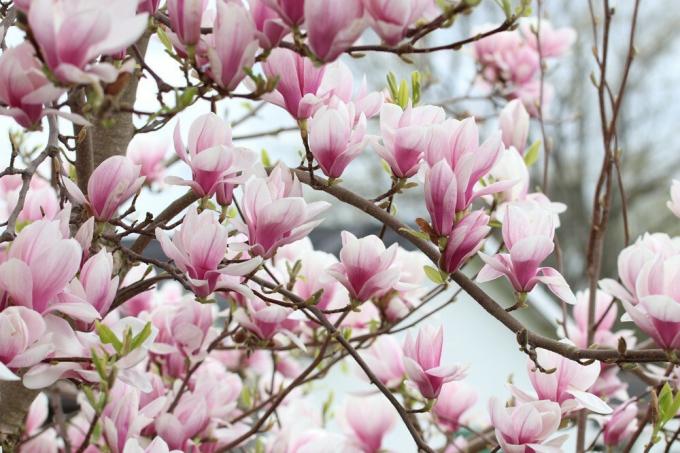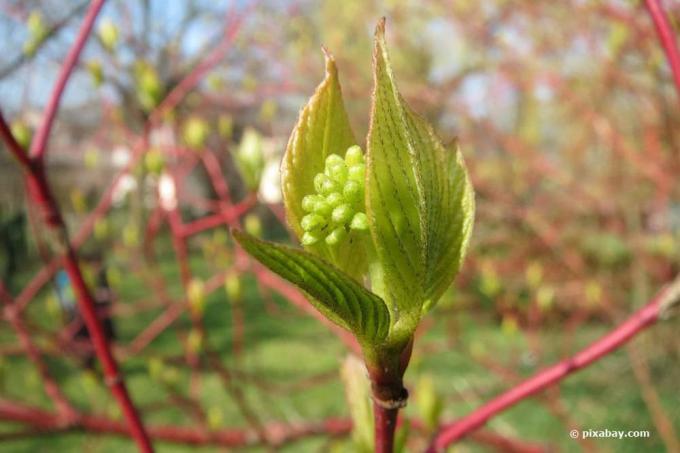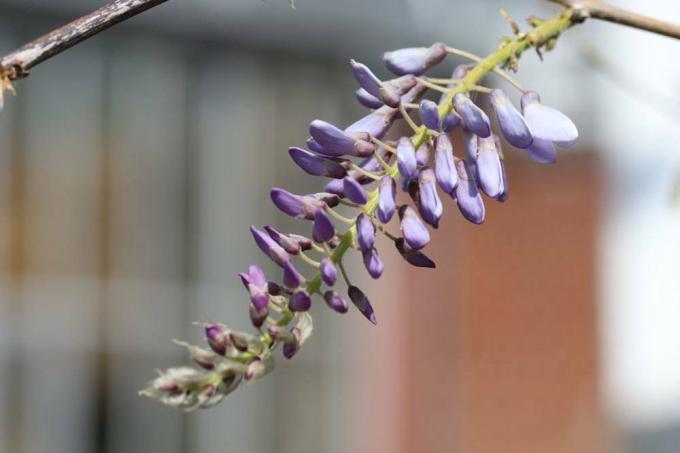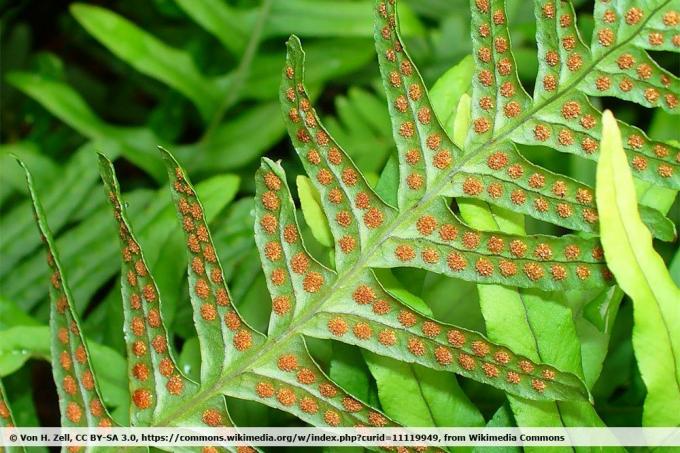
table of contents
- Plants sensitive to lime
- 1. Chinese wisteria (Wisteria sinensis)
- 2. Common potted fern (Polypodium vulgare)
- 3. Bell heather (Erica tetralix)
- 4. Houseleek (Sempervivum)
- 5. Hydrangea
- 6. Camellias (Camellia japonica)
- 7. Toad Lily (Tricyrtis hirta)
- 8. Magnolias (Magnolia)
- 9. rhododendron
- 10. Red dogwood (Cornus sanguinea)
Hobby gardeners can only look forward to magnificent plant growth if the soil meets the individual requirements of the plants. In addition to the supply of nutrients, depending on the pH value of the soil, the addition of lime is often necessary. Because lime neutralizes and facilitates the nutrient absorption of the plants. It is important to dose lime in the garden with sensitivity and to pay attention to the plants that cannot tolerate lime. In the following, we present 10 plants that are sensitive to lime.
Plants sensitive to lime
1. Chinese wisteria (Wisteria sinensis)
The Chinese Wisteria is a vigorous representative of the butterflies. It is also known as wisteria. The ornamental wood from China reaches a height of up to ten meters in Central European gardens. The decorative plants with blue and white flowers are available from specialist retailers. No matter whether in blue or white, the plant exerts a great attraction on bees, butterflies and flower-visiting insects.
- Soil: moist, well-drained, humus, sandy, loamy
- Location: sunny, warm, sheltered from the wind
- Flowering period: May to June
- Planting time: in late spring
- Propagation: cuttings
- Height: up to 10 meters
- Use: flower decorations, climbing plants, wall greening
- Care: water sufficiently, fertilize regularly with rhododendron fertilizer, pruning in spring and autumn, climbing aids required
- Winter storage: hardy
- Diseases / pests: voles, spider mites, aphids
2. Common potted fern (Polypodium vulgare)
The common potted fern is also called angelica, angelica, oak fern or stone fern. The plant is also widespread in Europe. Spotted fern is very popular with garden designers, because the green ground cover makes an excellent contribution to the harmonious appearance of properties. The plant also does not tolerate lime.
- Soil: dry, not very humus
- Location: shady to partially shaded
- Flowering time: no flowers
- Planting time: spring
- Multiplication: by division
- Height: 10 to 50 centimeters
- Use: leaf decoration, medicinal plant
- Care: only water moderately if it has been dry for a long time
- Winter storage: hardy
- Diseases / pests: scale insects
By the way, the common potted fern is also used as a medicinal plant. Its ingredients are used against rheumatism, gout, asthma, bronchitis, hoarseness and skin diseases.
3. Bell heather (Erica tetralix)
When the blossoms in the front garden decrease in autumn, the time for the pink bell heather in bloom begins. Like all Erika plants (Ericaceae), however, it is one of those plants that cannot tolerate lime in the soil. The bell heather is often referred to as bog heather, which indicates its preference for moist soils.
- Soil: moist, well-drained, humic, peaty
- Location: sunny to semi-sunny
- Flowering period: June to September
- Planting time: in late spring
- Propagation: cuttings
- Height: 20 to 50 centimeters
- Use: container plant, ornamental plant, suitable for dry bouquets
- Care: water sufficiently, fertilize regularly with rhododendron fertilizer, cut back in February
- Winter storage: hardy, but winter protection recommended
- Diseases / pests: powdery mildew, aphids
4. Houseleek (Sempervivum)
There is not just one houseleek, but more than 60 species with more than 3000 different varieties. It is also known under the names Steinwurz or Dachwurz. Sempervivum species are real Beginner Plants. Even if you don't have a green thumb, the robust plant, which thrives even in extreme locations, will reward you with beautiful growth and decorative flowers.
Spiderweb houseleek (Sempervivum arachnoidem), the mountain houseleek (Sempervivum montanum) and the wulfen houseleek known as stone rose (Sempervivum wulfenii).
- Soil: dry, well-drained, gravelly
- Location: partially shaded to sunny
- Flowering period: June to September
- Planting time: spring
- Propagation: through daughter rosettes and seeds
- Height: 10 to 60 centimeters, depending on the variety
- Use: rockery, green roofs, container plants, medicinal plants
- Care: do not water, do not fertilize
- Winter storage: hardy
- Diseases / pests: none
Did you know that “Sempervivum” means “always alive” in Latin?

5. Hydrangea
Hydrangeas have made a comeback in recent years. Because if the flowers were considered old-fashioned for a long time, they should not be missing in any garden today. Snowball, plate, climbing, panicle or garden hydrangeas enchant with beautiful white, pink, blue and purple flowers. There is not much you can go wrong with maintenance either. However, the flowering plant does not like lime in the soil.
- Soil: sandy, loamy, moist
- Location: shady to partially shaded
- Flowering period: July to September
- Planting time: spring
- Propagation: by cuttings
- Height: 1 to 7 meters depending on the variety
- Use: cut flower, container plant
- Care: water regularly and extensively
- Overwintering: overwinter potted plants in cool rooms, protect outdoor plants with fleece
- Diseases / pests: powdery mildew, mites, chlorosis if there is too much lime in the soil

tip: The composition of the rhododendron soil available on the market is well matched to the special requirements of lime-sensitive garden plants. If possible, use rainwater for watering. However, you should use other irrigation water beforehand descale.
6. Camellias (Camellia japonica)
More than 300 species of camellia are known. The lime-sensitive plant with the elegant, rose-like flowers comes from Asia. Already in the 15th In the 19th century, its leaves were used to make tea. It was for this reason that she came to Europe. If you design your garden based on the Japanese model, you cannot ignore the beautiful white or pink flowering plant. Camellias have similar requirements as rhododendrons and can be combined with them excellently.
- Soil: moist, well-drained, humic, peaty
- Location: partially shaded to sunny, sheltered from the wind
- Flowering period: March to May
- Planting time: in late spring
- Propagation: cuttings
- Height: 1.5 to 6 meters
- Use: container plant, garden shrub, specimen plant
- Care: water sufficiently, fertilize regularly with rhododendron fertilizer, cut back in February
- Winter storage: hardy to -15 ° C with winter protection, overwinter potted plants in cool, dark rooms
- Diseases / pests: black weevils, mealybugs

7. Toad Lily (Tricyrtis hirta)
Despite its name, the toad lily is one of the most elegant garden flowers. It belongs to the lily family and comes from Japan. The toad lily impresses with its dotted flowers in white, yellow, pink or purple. The plant also does not tolerate lime in the soil.
- Soil: moist, humic
- Location: shady to partially shaded, sheltered from the wind
- Flowering period: August to October
- Planting time: spring
- Height: up to 1 meter
- Propagation: by division and onions
- Use: cut flower
- Care: water well regularly
- Winter storage: frost hardy, but winter protection required
- Diseases / pests: slugs, lily beetles
8. Magnolias (Magnolia)
Every year in spring, the magnolias enchant us with their splendor of flowers. If the flowers fail, it may be due to the lime content of the soil. Magnolias are also one of those sensitive plants that cannot tolerate lime.
The specialist trade offers a wide range of magnolias. Many species thrive excellently in our regions. The most popular varieties in Germany include the Asian-looking star magnolias (Magnolia stellata), the lily-flowered magnolias (Magnolia liliiflora) and the Tulip magnolia (Magnolia x soulangeana).
- Soil: moist, well-drained, humic
- Location: sunny
- Flowering period: April to May or July to August
- Planting time: in late spring
- Propagation: cuttings
- Height: 1 to 20 meters
- Use: container plant, ornamental plant
- Care: water sufficiently, fertilize regularly with rhododendron fertilizer, cut back in autumn
- Overwintering: hardy with winter protection, while potted plants overwinter in cool, dark rooms
- Diseases / pests: powdery mildew, leaf spot disease, scale insects

Did you know that magnolia plants belong to the oldest known flowering plant families? Because they already settled on earth 100 million years ago. All of the deciduous trees known today emerged from this ancient plant.
9. rhododendron
Rhododendrons are also among those plants that are sensitive to lime in the soil. On the other hand, they prefer slightly acidic soil. More than 1000 species of the decorative shrub, also known as alpine rose, with white, pink or salmon-colored, purple, blue or yellow flowers are known. These include small dwarf rhododendrons and large trees. In the Alps, the rust-leaved alpine rose (rhododendron ferrugineum) and the lashed alpine rose (Rhododendron hirsutum). In the mountains, the evergreen woody plants rose blossoms find good conditions despite the harsh climate.
- Soil: slightly moist, well-drained, stony, loamy
- Location: partially shaded to sunny
- Flowering period: March to May
- Planting time: in late spring
- Propagation: offshoots, cuttings, seeds
- Height: depending on the variety up to 3 meters
- Use: container plant, garden shrub
- Care: water sufficiently, especially during flowering, fertilize regularly
- Winter storage: hardy
- Diseases / pests: Rhododendron cicada, black weevil, rhododendron net bug, powdery mildew, chlorosis if the lime content is too high

Note: If yellow discoloration can be observed on the leaves of plants that are sensitive to lime, chlorosis may be the cause. This disease manifests itself, among other things, in lime-sensitive flowers and bushes when the lime content in the soil is too high.
10. Red dogwood (Cornus sanguinea)
The red dogwood adorns many front gardens and is also one of the lime-sensitive plants. Not the flowers, but the blood-red color of the foliage gave the popular wood its name. The white flowers appear in early summer and form a fascinating contrast to the red leaves. After flowering, dark blue fruits develop, which are of great interest to the birds in the garden.
- Soil: slightly moist, well-drained, loamy
- Location: partially shaded to sunny
- Flowering period: June to July
- Planting time: spring or autumn
- Propagation: offshoots, cuttings
- Height: depending on the variety up to 2.5 meters
- Use: hedge wood, specimen plant
- Care: water sufficiently, especially during flowering, fertilize regularly, avoid waterlogging, cut back in autumn
- Winter storage: hardy
- Diseases / pests: powdery mildew







